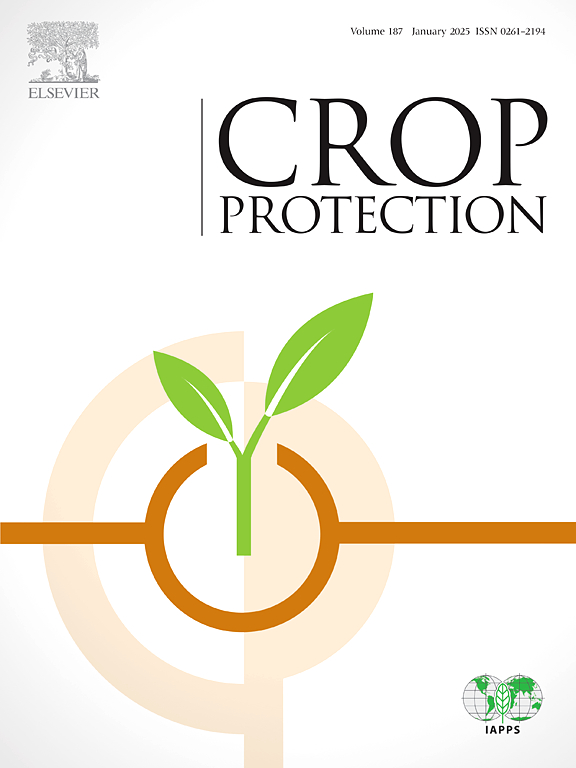氰氨酰胺诱导的秋粘虫代际亚致死效应
IF 2.5
2区 农林科学
Q1 AGRONOMY
引用次数: 0
摘要
氰胺虫胺是一种新型的用于防治秋粘虫(Spodoptera frugiperda)的杀虫剂;然而,对不同代frugiperda的亚致死暴露氰氨虫尚无充分的研究。本研究旨在利用年龄-分期、两性生命表软件,评估氰氨酰丙烯对frugiperda亲代(F0)生物学和人口统计学参数的亚致死效应,以及对子代(F1)的代际效应。生物测定结果表明,氰氨虫胺对果螨的毒性较强,处理96 h后LC50值为0.439 mg/kg。F0S的幼虫期。低致死浓度(LC30)和亚致死浓度(LC10)处理后,frugiperda显著增加。处理组成虫寿命缩短,蛹期延长。处理组成虫产卵前期(APOP)和总产卵前期(TPOP)均高于对照组。F0代和F1代的繁殖力分别在LC10和LC30处显著降低。F0代LC10和LC30的相对适合度(Rf)分别为0.45和0.32,F1代的相对适合度分别为0.65和0.48。综上所述,氰氨酰胺的LC10和LC30均对frugiperda的生命表特性产生了负面影响,最终抑制了种群的生长。这些发现可能对了解氰氨酰胺对frugiperda生命史特征的总体影响至关重要,可能有助于在开放条件下管理这种入侵害虫。本文章由计算机程序翻译,如有差异,请以英文原文为准。
Cyantraniliprole-induced intergenerational sublethal effects on fall armyworm, Spodoptera frugiperda
Cyantraniliprole is a novel anthranilic diamide insecticide commonly used against fall armyworm, Spodoptera frugiperda ; however, sublethal exposure of cyantraniliprole on different generations of S . frugiperda , has not been fully studied. This proposed study aimed to estimate the sublethal effects of cyantraniliprole on the biological and demographic parameters of parental generation (F0 ) and intergenerational effects on the offspring generation (F1 ) of S. frugiperda using Age-stage, two-sex life table software. The bioassay result proved the strong toxicity of cyantraniliprole toward S. frugiperda , as demonstrated by an LC50 value of 0.439 mg/kg after 96 h treatment. The larval duration of F0 S. frugiperda significantly increased when treated with the low lethal (LC30 ) and sublethal (LC10 ) concentrations of cyantraniliprole. Adult longevities were decreased while pupal duration was increased in the treated groups. The adult preoviposition period (APOP) and total preoviposition period (TPOP) were higher in the treated groups compared to the control. Moreover, the fecundity was significantly decreased at the LC10 and LC30 in the F0 and F1 generations, respectively. For the F0 generation, the relative fitness (R f 10 and LC30 were 0.45 and 0.32, while for the F1 generation, the values were 0.65 and 0.48, respectively. In summary, our results showed that life table characteristics of S. frugiperda were negatively affected by LC10 and LC30 of cyantraniliprole, ultimately inhibiting population growth. These findings may be crucial for understanding the overall impact of cyantraniliprole on the life-history traits of S. frugiperda , potentially aiding in the management of this invasive pest in open-field conditions.
求助全文
通过发布文献求助,成功后即可免费获取论文全文。
去求助
来源期刊

Crop Protection
农林科学-农艺学
CiteScore
6.10
自引率
3.60%
发文量
200
审稿时长
29 days
期刊介绍:
The Editors of Crop Protection especially welcome papers describing an interdisciplinary approach showing how different control strategies can be integrated into practical pest management programs, covering high and low input agricultural systems worldwide. Crop Protection particularly emphasizes the practical aspects of control in the field and for protected crops, and includes work which may lead in the near future to more effective control. The journal does not duplicate the many existing excellent biological science journals, which deal mainly with the more fundamental aspects of plant pathology, applied zoology and weed science. Crop Protection covers all practical aspects of pest, disease and weed control, including the following topics:
-Abiotic damage-
Agronomic control methods-
Assessment of pest and disease damage-
Molecular methods for the detection and assessment of pests and diseases-
Biological control-
Biorational pesticides-
Control of animal pests of world crops-
Control of diseases of crop plants caused by microorganisms-
Control of weeds and integrated management-
Economic considerations-
Effects of plant growth regulators-
Environmental benefits of reduced pesticide use-
Environmental effects of pesticides-
Epidemiology of pests and diseases in relation to control-
GM Crops, and genetic engineering applications-
Importance and control of postharvest crop losses-
Integrated control-
Interrelationships and compatibility among different control strategies-
Invasive species as they relate to implications for crop protection-
Pesticide application methods-
Pest management-
Phytobiomes for pest and disease control-
Resistance management-
Sampling and monitoring schemes for diseases, nematodes, pests and weeds.
 求助内容:
求助内容: 应助结果提醒方式:
应助结果提醒方式:


